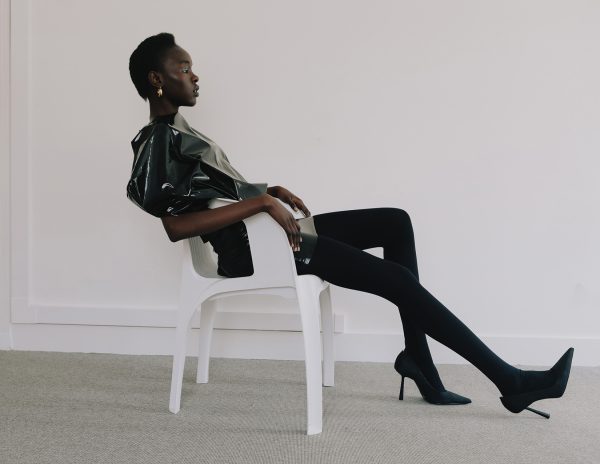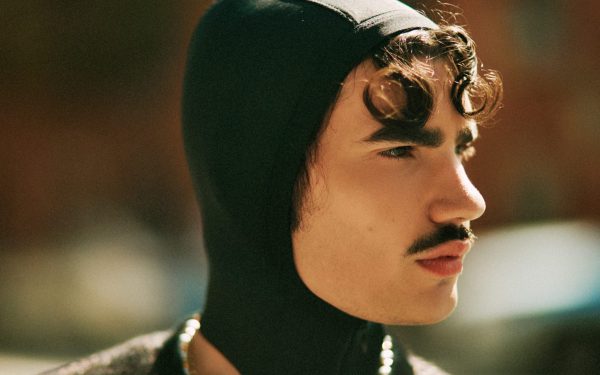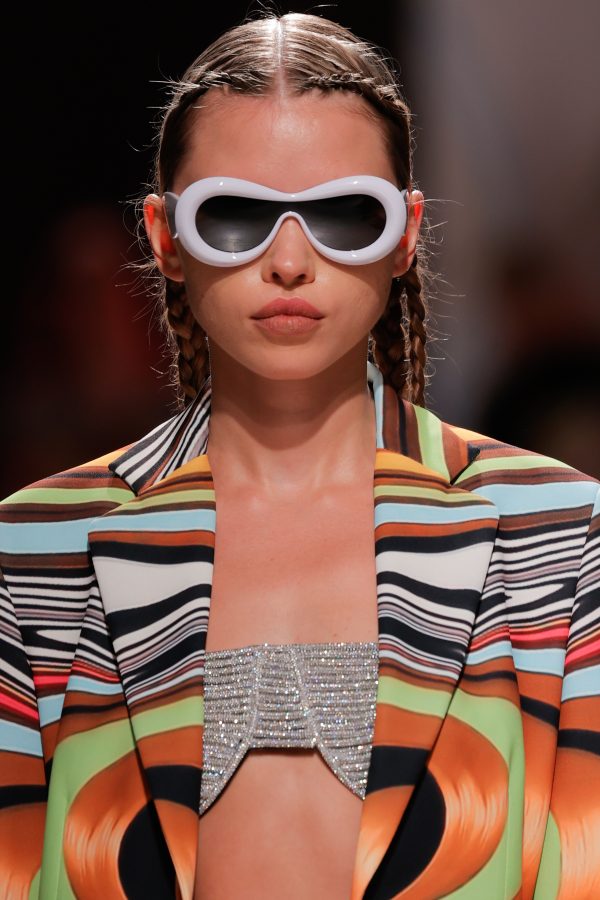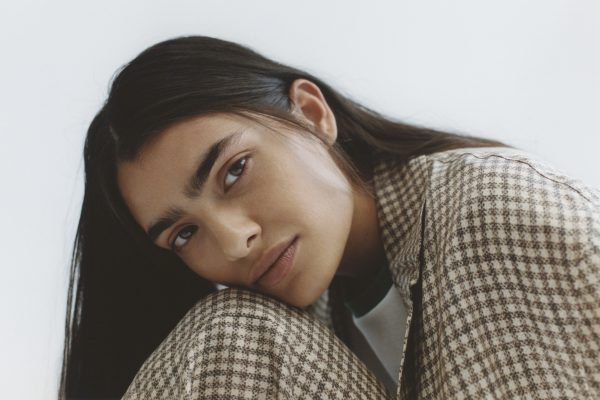
full looks. Izzy Du
photography. Lee Wei Swee
models. Emma Van der Strieck + Marina Jagoda
make up. Jenneke Croubels
“Take me to see the sunset,
I’ll take you to Sea.
Drag me into the storm,
I’ll make it out afore dawn.
I stand strong as the winds blow but you blow me away.”
So begins an original poem by Izzy Du, the Chengdu, China-born designer behind You Blow Me Away. Being born in southwestern China, Du grew up in Vancouver, Canada, eventually making her way to London for her foundation year at Central Saint Martins. It was there she found a way to bridge her many skills and interests into fashion — a medium she’s found refuge in since her youth.
You Blow Me Away, the collection she’s currently presenting is bold – in her own words, “You Blow Me Away is for the most dangerous beings you’ll ever meet, the modern femme fatales.” Fiery hues bleed into darkness, with occasional silvery textures layering and wavering in an almost dreamlike manner.
Du, who is currently continuing her education at the Royal Academy of Antwerp, took a break from her studies to answer some questions for Schön! about her history, You Blow Me Away, and what we can look forward to from her in the future.

full look. Izzy Du
The Scorpion puffer.
an 800 fill power goose-down puffer dress with detachable intertwining pieces connected by eco-friendly re-upholstered fish-leather straps.
photography. Mika Kailes
model. Yamar Diouf @ Jill Models
make up. Laura Noben
image. Courtesy of ‘Subject’ Magazine
opposite
full look. Izzy Du
photography. Lee Wei Swee
model. Marina Jagoda
make up. Jenneke Croubels
How did you begin your involvement with fashion?
Growing up, none of my immediate environments were remotely related to fashion. I went to boarding school in Chengdu when I was in kindergarten, then went to a private school in Vancouver and wore a uniform for seven years. Yet I always watched and observed, so fascinated because I knew I too wanted to create something that could be enjoyed in all parts of the world. I believe clothing should be reminiscent of a feeling, an idea; a physical way for all people to experience a world where they are exactly what they want to be.
Although I grew up in Western culture, I am very much Chinese. It took some time but I eventually found a way to bridge the two cultures. My mother is insane about fashion and dress, ever since I can remember. I guess in a way that has been ingrained in me since I was four, [when] I would try on her Versace heels when she wasn’t home. She would always say in Chinese, “we are 30% defined by looks and 70% by the way we dress.”
I’ve loved the arts since I was very little; dancing, playing piano, painting. When I was fifteen, I took sewing lessons outside of school and found an amazing studio where I discovered the medium to best materialise all these peculiar thoughts in my head. Although my parents have traditional values and ideals, they supported what I truly wanted to pursue and my wishes to go to London.

full look. Izzy Du
photography. Lee Wei Swee
model. Margarita Avtenyeva
make up. Jenneke Croubels
opposite
full look. Izzy Du
photography. Lee Wei Swee
model. Emma Van der Strieck
make up. Jenneke Croubels
You describe this collection as being “for the most dangerous beings you’ll ever meet – the modern femme fatales.” What do you think it means to be “dangerous”?
To me, danger is seductive and multi-sided. It is someone who is unpredictable because they follow their own will and is unafraid to get lost on a path that can’t be seen. It is the darkness and the complication in every idea that piques my interest. The possibility that a good idea, like an innocent drive through the woods or wearing a puffer because it might be cold out, can turn into the strangest, most perilous situation. I want to dress a formidable woman who can handle all that while looking fabulous.
You included a poem with the background information for this collection. In what ways did this poem influence your work?
It is actually an excerpt from a longer passage I wrote. This collection is a physical expression of this poem. It speaks about a kind of push and pull relationship, whether it be with a person or something else. The reasons for the relationship are so incomprehensible, yet still, it just takes your breath away.

full looks. Izzy Du
photography. Lee Wei Swee
models. Emma Van der Strieck + Marina Jagoda
make up. Jenneke Croubels
You’ve mentioned that this collection was in part inspired by the golden age of Hollywood. How did you come to use old Hollywood as inspiration, and where do you see that manifested in these pieces?
I always had an admiration for film, and for this collection, I wanted to look at a time when everything was fresh and fascinating – cinematography in the 1930s when that new kind of celebrity emerged. The actresses came from tales of rags to riches, regular girls whisked away to be stars, much like the opportunities social media provides in contemporary times. From rouge to scandalous feathers, there was a kind of buzz and excitement that is so difficult to arouse in the times we exist in today.
[There were] many costume problems in terms of line, texture, and lighting on materials like sequins and tinsel when cinema moved past silent films. For example, beaded dresses made too much noise [and] were too expensive for production costs, whilst fur and feathers convey the same luxury but also absorb light instead of reflecting it. I wanted to find the equivalent in contemporary materials. The beauty of it all was that the cinema sold dreams and aspirations; the actors/actresses were groomed to fit particular archetypes. The means of escape through velvet tearooms… It all seems so romantic.

full look. Izzy Du
photography. Lee Wei Swee
model. Margarita Avtenyeva
make up. Jenneke Croubels
opposite
full look. Izzy Du
photography. Lee Wei Swee
model. Emma Van der Strieck
make up. Jenneke Croubels
Did you have any other aesthetic inspirations for this collection?
Yes, for sure. I absolutely love the work of the painters Willem de Kooning and Arshile Gorky; the energy in their strokes was an inspiration for the fabrics and material treatments I did. I am also a huge fan of David Lynch and Wong Kar Wai – the mood and atmosphere held throughout their work is really something. Another element was the natural human form, which to me is beautiful on its own. Fashion is about creating something that moves with the body, distorts it or enhances it [so] that the garment has the power to merge with its wearer. The colour scheme throughout the collection is the range of hues seen in the sky during different times of the day. The make and tailoring of a proper men’s suit are a large part of the collection. I combined traditional men’s tailoring with corsetry so that the silhouettes have sharp contrasts between soft and hard in terms of shape and texture.

full look. Izzy Du
photography. Zhuo Chen
model. Yamar Diouf @ Jill Models
make up. Laura Noben
image. Courtesy of ‘Subject’ Magazine
What can you tell us about this photo series?
The photo series is a porthole into the realm in which the women who wear these garments exist. It conveys the impressions they make in movement. It is about what you see clearly amongst the darkness. Black, as a palette on its own, is the foremost part of the collection and is expressed through the photos as well. I think the photographers, my friends, really captured that aesthetic and brought it out.

all clothing. Izzy Du
3-d printed ear piece. Izzy Du X Evgeny Mezhibovskiy
photography. Lee Wei Swee
model. Emma Van der Strieck
make up. Jenneke Croubels
opposite
full look. Izzy Du
photography. Lee Wei Swee
model. Margarita Avtenyeva
make up. Jenneke Croubels
How does the concept of “dreaming” play into both these photos and the collection as a whole?
The collection features an array of bad dreams from which you wake up and you’re not scared anymore. You realise they were actually really beautiful. Almost all my dreams are lucid nightmares, so I am always somewhat aware that I am dreaming in order to control the terrifying elements. For example, I am walking on a vast glass carpet that stretches on forever, but it starts to crack with every step I take. Or I am trapped in a golden tesseract and gas suddenly floods the box; when I can’t bear it anymore, I create a window in the wall and escape. That peculiar sense of “control” is imparted throughout the collection.

What do you have upcoming?
In the coming year, I will be doing my first menswear collection at the Academy. Fashion is gender fluid and increasingly so, and to me, it’s not about men or women but about dressing all people to look their most handsome. This collection is very much conceptual, so next, I’d like to incorporate elements of utility on top of all that extravagance. I’m very excited… There is much I want to try and I have some weird ideas, so hopefully, it all goes well!
Make sure to follow Izzy Du on Instagram to keep up with her future ventures.
all designs. Izzy Du
photography. Lee Wei Swee, Mika Kailes, Zhuo Chen
models. Yamar Diouf + Margarita Avtenyeva @ Jill Models, Emma Van der Strieck, Marina Jagoda
make up. Jenneke Croubels, Laura Noben






































































































